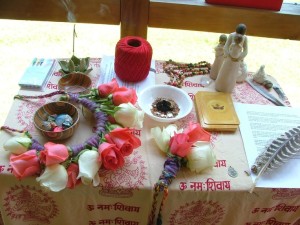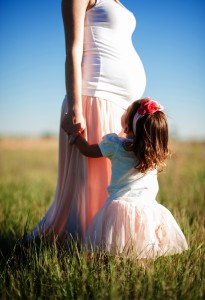
A Ritual for Birth is known as a Birthingway and is a ceremony for a pregnant person just before they are due to give birth. It is the ceremony that was the precursor to Baby Showers. The ritual was designed to empower people before they stood in the threshold between life and death to bring another life into this world.
Preparation:
Items in middle of circle: bowl for beads, candle, shell, feather, rock, Mother Earth Statue, Singing bowl, red cord & scissors, bowl of eggs & all other blessings, paper and pen. You can use Sea shells to mark about a big circle around the room.
A Birthingway is also known as a Blessingway Ceremony by the Navajo People, it is as old as their people’s history. These rites-of-passage are also honoured by earth based religions such as Wicca. A Birthingway is a rite to empower the parent-to-be to surrender to the mysteries of labour and birth and to give them strength for the ordeal. It is a very positive ritual affirming that the pregnant person will have a beautiful birth experience.
The Birthingway ritual is a template for childbirth. Beginning with stories from the other people present of their birth experience is like the stage of early labour. Once the stories have been shared then there is a group activity which is akin to active labour. The Peak of the ceremony is the wish giving, which is the most emotionally intense part of the Birthingway and is like the birth. The closing words or blessing is similar to the delivering of the placenta. Finally the feasting is just like the postpartum time then the new mother can be congratulated and fested.

Being the ceremony by ringing a bell, a singing bowl or holding up a hand for silence.
Then you can share this beautiful Birth story…as told by a five year old boy from India, named Jai Gopal, who was present at the birth of his brother.
Jai was asked ‘What happened’, he replied “Fire”, perhaps referring to the fire lit to warm the mother and banish evil spirits. And then after a pause he said “Blood” and another pause, “Water”, another pause “Pain”, one final pause “Life!”
Birth is a ritual that invokes the elements as illustrated by Jai’s story. The timeless strength of the elements can be invoked to help support the mother to be.
Powers of the East, the Air, the deep breathing of labour and the first breath of the new baby, join our circle.
Powers of the South, the Fire, light of life and intensity of labour, join our circle.
Powers of West, the Water, water of life and the waters of the womb, join our circle.
Powers of North, the Earth, the direction of the ancestors and Grandmothers who watch over women during birth, join our circle.
As well as honouring the mother to be we also honour the strength and beauty of all the people in this circle as life bringers. Which does not necessarily mean we have all given bith to children. Some of us have birthed gardens, or art, or work or many other creative projects. As people we all mother something.
I would like to invite people to speak if they would like to about a positive birth experience they have had.
As a birthing person _______ is about to stand at the gateway, the realm between the worlds, to bring a new soul into our world. ________ has a shamanic journey ahead of them, a spiritual vision quest. We meet to support and encourage ____________ in their journey.
I would like us to remember a time when all life was held sacred and women especially so for being the bearers of new life…
Traditionally the Goddesses of Birth and Mothering were asked to join the circle. Let me tell you about some of them…
Juno was the Great Roman Mother Goddess who protected expectant mothers and their unborn children during pregnancy and birth.
It was believed that Juno watched over women from their first to last breaths. Roman women referred to their souls as Juno in honour of the Goddess. The first of March was her sacred day and every year on that day all the women held a festival in honour of Juno, thanking her for her help. During this festival women asked Juno to help them give birth to healthy babies. The month of June is named after Juno.
Juno, originally a moon goddess, was worshipped as the giver of life on the full moon, hence our meeting on the full moon. Round like a pregnant woman’s belly, the moon was believed to symbolize the ability of women to bear children. Newborn babies were said to be blessed and guarded by Juno.
The moon was tremendously important to early peoples as they relied on it for a calendar to tell them when to plant the crops. This luminous orb influenced the ebb and flow of the sea, the growth of the crops and the fertility of women. It was believed that the light of the moon helped the baby to grow in the womb, like a seed in the dark earth. Juno was invoked for protection by labouring mothers and she was honoured as the preserver and Queen of Mothers.
Renenet the Egyptain Goddess who was invoked during labour, depicted as woman with the head of a lion or serpent.
Renenet was responsible for creating the new baby’s desire to nurse, essentially the same as granting it life. But even more important to the Ancient Egyptians Renenet granted the child its ‘ren’ or soul name – the secret name that animated the child outside of the womb. This soul name could only be bestowed by the baby’s mother. In addition to protecting the baby from harm, the magical sound of this name held within its syllables the child’s future. It also revealed the child’s personality and place in the world. This special name was kept secret for an enemy to discover it was an opportunity to gain power over the name-bearer.
The ancient hieroglyph ‘mena’ meaning breast and moon is symbolized by a breast, reflecting the Egyptians belief that from the breast of the Moon Goddess flowed the Milky Way, the stars and the life-giving waters of the universe.
Yemaya – Cuban Santeria Goddess of the Caribbean Sea, she rules the waters that nurture new life within the womb as well as the ocean.
The Santeria religion was developed by the enslaved Yoruba people, who were brought from their native Nigeria to Cuba to work on the sugar plantations in the nineteenth century.
Yemaya, Holy Queen Sea, was the divine mother of the fourteen gods and goddesses who made up the sacred pantheon of the Santeria religion. She reigns over fertility and motherhood, moon, sea, women – the eternal cycles of all life, all fall under her domain. Sea shells are sacred to Yemaya as she owns all the riches of the oceans. Sea shells have always been seen to have magical powers, used in the old rites of weddings and farming their graceful curves and enigmatic interior spaces are like women themselves. They symbolize our regenerative powers and the life giving forces of the ocean and moon.
We come together tonight to honour the upcoming birth and the sacred new life that ________ is about to bring forth, offering a circle of love and blessings for their labour and birth.
Time to give our beads to the mother-to-be. The beads will be made into a bracelet for the mother-to-be to wear or hold in labour. This ideas was modeled after Birthing Beads from an African tribe – a midwife will bring their birthing beads to each labour for the mother to hold and use like prayer beads or a rosary. After the birth the mother will present their midwife with a new bead to add to their string.
Will everyone find their bead and think of the wish they would like to make for the mother-to-be to remember in labour. Please say what you wish for mother-to-be during labour….
An example of a wish:
This bead is made from a sacred sea shell of Yemena and will impart her protection in labour. To help _________ to feel her connection to the ocean of life and her link to all other people that have birthed and the 400,000 other mothers who are labouring at the same time that they are, such that they may bring a new life into the world.
–
In other cultures birth is honoured as an initiation that transforms people in dramatic ways. Men have no equivalent and it is said by some North American Aboriginals that the Sun Dance is performed to match the experience and call up the courage that labouring mothers endure.
In the First Nations’ Tradition and in the Sudan each pregnant person is honoured at a special ceremony. Their hair is hennaed, braided and scented, they wear a special bracelet and lie on a ceremonial mat made of palm leaf stems. Their relatives gather around to rub their belly with handfuls of millet porridge as a symbol of regeneration.
Mansi women assist the expectant mother by the ritual preparation of birch-bark cradles and special coverlets of swan skin and pillows of deer fur, twice the size of the mother’s hand. Once these are ready they begin work on a reed mattress on which the new mother will sit and sleep for a certain number of days following her child’s birth.
The Kalapalo women of Brazil make a new hammock for the pregnant women of their community and suspending it above the old hammock of each pregnant woman. During labour the woman uses the new hammock for support while lying in the old one. After delivery the old hammock is thrown away and the mother and baby sleep in the new one.
In Morocco a woman in labour will be surrounded by three rings of belly dancing women. Belly dancing was originally exclusively for labouring women to teach them all the different ways to move their bodies to help labour and as a form of honouring the earth mother Goddess.
When a woman is about to go into labour in Ireland, India and Siberia family members set animals free, loosen their hair, unlock doors and leave pots uncovered. These acts symbolize the removal of any obstruction during birth.
In Guatemala a baby is not ‘delivered’ but ‘received’.
In the Sioux Language one word for pregnancy is ‘growing strong’.
In China a pregnant woman is said to have ‘happiness in her body’.
Our intent in holding this Birthingway is to strengthen _______’s links with their community and to replace any fear or worry with affirmations of the sacredness of birth honouring the process as the gateway for new life.
Poem by Paracelsus (1493 –1541)
Woman is the artist of the imagination
and the child in the womb
is the canvas whereon she painteth her pictures.
Here are the words for Mother in 25 languages. These can be spoken together as a group as a chant.
Nana, el-oum, mayka, matka, moder, moeder, mother, ema, aiti, mere, mutter, mite’ra, anya, madre, made, motina, mor, matka, mae, mama, mat, majka, madre, moder, anne.
Eggs are also traditional at Birthing Ways, symbols of fertility and new life, spring and birth. A bowl containing three eggs is passed around the circle, each person may speak three blessings, one for the mother, one for the baby and one for the global community of women.
You can add these items to the bowl of eggs once the wishes have been spoken:
Motherwort (herb) for happiness
Garlic to avert negative energy
Vervain (herb) for creativity
Sage for protection
Bread and milk so that the baby will never know hunger or thirst
Coins so the baby shall never know want and always manifest abundance
Rose petals for love
Chocolate – always know the sweetness in life
These eggs blessed by the circle of mothers are to be buried as in the earth these wishes will grow.
Next we would traditionally change the mother-to-be’s hairstyle. If I they wearing her hair tied up we would take it down to symbolize the change of mind needed to be with the young, more free-flowing. If they had her hair down we brush it and tie it up on her head to symbolize the change from carefree maiden to responsible mother. This would also be a time to add decorations to the mother-to-be’s hair such as feathers, beads and shells. After the birth these decorations are carefully taken out of her hair and made into a mobile for the baby.
You can unite all of the people in the circle by lightly tying a length of red ribbon around their wrists one at a time… make sure to tie a bracelet on each wrist as these will be cut off later in the ritual.
Buddhists and the Navajo have a tradition of tying a piece of red string around the wrist of a pregnant person’s family members and friends as a way of keeping vigil for the birth.
Like the First Nations’ Deity, ‘Spider Woman’ who weaves the web of life, we all have our strand of that web to weave our own lives and are related to every other fiber of the web.
Chant
We are the weavers, we are the web
We are the flow, we are the ebb
Native Americans teach that we are all linked to the earth through and invisible umbilical cord.
We are all linked to symbolize the umbilical cord connection between the mother-to-be and their baby and our connection as members of this community. We are all one, sisters (and brothers) united to support a fellow person about to bring a new life into the world.
Each person says in turn…
“As I wear this bracelet I will think of _________ and their coming birth”
Everyone repeats this as the leader goes around the circle cutting everyone’s connection. These bracelets are a daily reminded to keep ____________ in our thoughts as they approaches the moment of birth.
__________ keeps the bracelet on to remind them of their Birthingway Celebration.
It appears that we are all separate but remember we are cut from the same length of cord.
Traditionally after the birth the yarn bracelets are burnt.
Many First Nations Peoples then have the ritual washing of the feet of the mother to be, usually dome by the Midwives. To honour the sacredness as the mother to be, at the gateway between life and death ushing in a new life.
After washing the feet cornmeal is rubbed on to dry them. Then a towel is used to rub off the meal and buff up the feet. This is a purifying practice, which using an ancient form of reflexology, clears the road for birth. The most precious substance in the culture is used, the body offering of the Corn Mother herself, who is sacred to the First Nations. Southwestern First Nations see corn as a Goddess. Corn is the sacred symbol of Corn Woman and corn is a sacred food given from Corn Woman to her people to sustain and nourish them. This demonstrates what a privilege it was to give birth and is to help the mother-to-be successfully walk the holy path of labour and birth.
The leader will give each person a small candle. With a lit candle __________________ will go around the circle and light every candle. _____________ then stands in the middle of the circle of candles and women and takes a minute to absorb all of the strength and love she feels from her community. The mother-to-be will envision all of you and your lights shining to give them courage as they labour and deliver their baby.
Then we all blow out our candles.
As a birthing mother _____________will need to see themself as an embodiment of the sacred feminine, enacting the most sacred ritual of all.
Thank all participants for attending.
Draw this part of the ceremony to a close by opening the circle we have created…
From a Navajo chant from the Blessingway ceremony;
With long life-happiness surrounding ____________
may _____________in blessing give birth!
May ___________ quickly give birth!
In blessing may _____________arise again, in blessing may ___________recover,
as one who is long life-happiness may _____________live on!
If earlier you invited the elements to attend you may invite them to take their leave.
Powers of the East, the Air, the deep breathing of labour and the first breath of the new baby, thank you for your blessings, go in peace.
Powers of the South, the Fire, light of the flame and intensity of labour, thank you for your blessings, go in peace.
Powers of West, the Water, water of life and the waters of the womb, thank you for your blessings, go in peace.
Powers of North, the Earth, the home of the ancestors and Grandmothers, thank you for your blessings, go in peace.
Chant: The earth, the water, the fire the air, return, return, return, return.
African Proverb “Woman is like the Godddess, because she gives birth to the people.”
